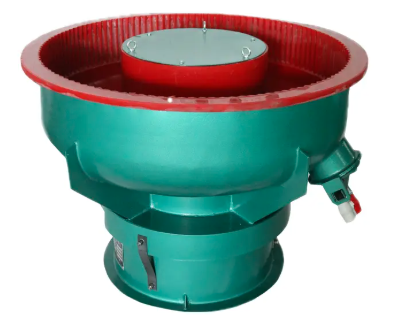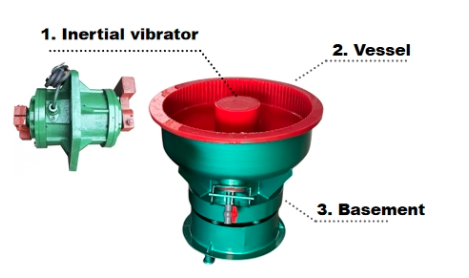- Home
- Machine
- Media
- Application
- Service
- About Us
- Blogs
- Contact Us
- All
- Product Name
- Product Keyword
- Product Model
- Product Summary
- Product Description
- Multi Field Search


Views: 0 Author: Site Editor Publish Time: 2025-10-15 Origin: Site











When it comes to industrial surface finishing, a vibratory polishing machine is more than just a tool—it’s a reliable solution for achieving smooth, polished, and burr-free parts quickly. These machines are widely used in metalworking, manufacturing, and precision component industries, handling everything from delicate small parts to heavy industrial castings. But many operators wonder: is a vibratory polishing machine easy to operate?
In this article, we will explore how these machines work, the factors that affect ease of operation, tips for maximizing efficiency, and why modern machines are designed to be user-friendly for both beginners and experienced operators. Whether you’re polishing, deburring, or cleaning, understanding these key points can help you get consistent, high-quality finishes with minimal effort.
A vibratory polishing machine is a tool used to smooth, polish, or deburr parts. It processes many components at the same time. They are popular in metalworking, manufacturing, and hobbyist workshops.
Typical applications include:
Deburring sharp edges
Polishing dull surfaces
Cleaning grease, rust, or dirt
Edge radiusing for rounded corners
There are three main types:
| Type | Description | Best For |
|---|---|---|
| Bowl | Circular, small-medium loads | General finishing |
| Tub | Rectangular, larger volumes | Mass finishing |
| Continuous | Conveyor-based | High-volume industrial use |
The machine relies on vibrations created by off-center motor weights. These vibrations move the bowl or tub in a rhythmic pattern. Parts and media rub together until surfaces are smooth.
It works in two main ways:
Wet finishing – water and compounds added for cleaning and polishing
Dry finishing – no liquids, faster for simple deburring
Operators can adjust frequency, amplitude, and duration to control how fast and fine the finish will be.

Modern vibratory polishing machines are designed for both efficiency and simplicity. The control panels often have intuitive layouts, making it easier for new operators to start working quickly. Operators can adjust:
Speed – Control how fast the bowl or tub vibrates, which directly affects finish quality.
Vibration amplitude – Fine-tunes the intensity of part-media contact for delicate or heavy-duty finishing.
Time cycles – Determines how long the process runs for optimal polishing or deburring.
Some machines include programmable features, allowing you to store multiple settings. This ensures repeatable results without manually adjusting the machine each time. Advanced machines may offer:
Digital displays showing real-time vibration frequency
Automatic cycle timers for wet or dry finishing
Reversible vibration motion to prevent media packing
Safety locks and emergency stop buttons
By designing user-friendly interfaces, manufacturers reduce training time, improve consistency, and minimize operator errors.
The choice of media is one of the most critical factors affecting operation ease and finish quality. The right media reduces cycle times and prevents part damage. Common types include:
Ceramic – Hard, durable, and ideal for general-purpose polishing or deburring.
Plastic – Softer, gentle on non-ferrous metals and delicate components.
Steel – Heavy and aggressive, accelerates material removal.
Organic – Corn cob, walnut shell, or other natural media; perfect for ultra-fine finishing or polishing sensitive surfaces.
Media-to-parts ratio influences the contact intensity between parts and media:
| Ratio | Effect | Typical Use |
|---|---|---|
| 1:1 | Rough finish | Castings |
| 3:1–5:1 | Moderate contact | Non-ferrous metals |
| 6:1–10:1 | Gentle polishing | Delicate parts |
| 20:1 | Ultra-fine finish | Fragile or precision parts |
Other considerations for media setup:
Shape – Triangular, cylindrical, or conical media can change the contact pattern.
Size – Larger media cuts faster but may leave a rough finish; smaller media yields smoother results.
Mixing media – Sometimes a combination improves polishing efficiency and reduces wear.
Proper media selection simplifies machine operation, reduces the need for repeated cycles, and helps achieve the desired finish more reliably.
How you load parts affects not only finish quality but also machine efficiency. Key points to consider:
Even loading – Distribute parts across the bowl to prevent clumping and uneven finishes.
Compartmentalized bowls – For fragile or irregular parts, compartments prevent collisions and scratching.
Separation of media types – Using multiple media types in one cycle may require separators to maintain consistent contact.
Even media distribution ensures:
Smooth, uniform surface finishes across all parts
Reduced total cycle time by maximizing media contact
Less wear and tear on both parts and media
Additional tips: rotate parts or adjust bowl layout periodically to maintain consistent polishing across all components.
Fluids are critical for improving polish, maintaining media effectiveness, and reducing dust. They can also enhance cleaning and prolong media life. Common compounds include:
Water – Base for most wet finishing processes
Detergents – Help remove grease or oil from surfaces
Rust inhibitors – Protect parts from oxidation during polishing
Continuous supply lines are very helpful in industrial setups. They:
Automatically feed compounds, reducing manual refills
Maintain consistent lubrication and cleaning
Prevent media from drying out or losing abrasiveness
Other practical points:
Monitor fluid levels to avoid media sticking or uneven finishes
Use biodegradable compounds where possible for environmental safety
Adjust compound concentration depending on part material and finish quality desired
Using the right combination of media, part loading, and compounds makes operation easier, more predictable, and more user-friendly, even for new operators.

Operating a user-friendly vibratory polishing machine comes with multiple benefits that impact both efficiency and product quality:
Lowers labor costs – Fewer manual steps are required, and operators can run multiple machines at once.
Speeds up production – Consistent vibration patterns allow several parts to be processed simultaneously, reducing cycle time.
Provides consistent finishes – Machines with programmable settings create uniform results, ensuring all parts meet quality standards.
Minimizes part damage – Proper media selection, compartmentalized bowls, and controlled vibration protect delicate or fragile components.
Works on industrial and delicate parts – From heavy castings to small precision components, these machines handle diverse workloads effectively.
Reduces training time – Simple controls and intuitive interfaces make it easier for new operators to start quickly.
Environmentally friendly options – Wet finishing with water-based compounds reduces chemical waste and dust.
By combining these advantages, operators can improve productivity while maintaining high-quality standards without constant supervision.
To get the most out of a vibratory polishing machine, consider these practical tips:
Match machine size to workload – Overloading reduces efficiency; too small a machine slows production.
Choose media that suits part material – Soft metals, plastics, or delicate components may require gentler media, while harder metals benefit from more aggressive media.
Adjust vibration frequency and amplitude correctly – Higher amplitude speeds up heavy material removal; lower amplitude protects fragile parts and improves fine finishes.
Use proper compounds for cleaning or polishing – Water, detergents, or rust inhibitors improve finish quality and reduce media wear.
Inspect machine and media regularly – Check motors, springs, and bowls for wear; replace worn media to maintain uniform results.
Rotate or rearrange parts when needed – Helps prevent uneven finishes and maximizes contact with media.
Keep the workspace clean – Prevents contamination of media and ensures safer operation.
Following these tips ensures the machine is not only easy to operate but also delivers reliable, high-quality results consistently.
A: It is used to smooth, deburr, polish, and clean parts. Common applications include edge radiusing, rust removal, and surface finishing for metals, plastics, ceramics, and delicate components.
A: Yes. Modern machines feature user-friendly control panels, programmable cycles, and adjustable settings. Beginners can learn basic operation quickly, while advanced features allow for consistent, repeatable results.
A: It uses off-center motor weights to create vibrations. Parts and media move in a circular or rolling motion, rubbing together to remove burrs, polish surfaces, and clean parts. Wet or dry finishing options are available.
A: Basic operation is straightforward. Most operators can learn from manuals, videos, or brief on-site guidance. Programmable and automated machines further reduce the learning curve.
A: Yes. Many machines have timers, programmable cycles, and automatic feeders to minimize human intervention while maintaining consistent finishes.
Operating a vibratory polishing machine doesn’t have to be complicated. By choosing the right machine, using appropriate media, and maintaining proper settings, operators can enjoy efficient, reliable, and high-quality results every time. Modern machines with intuitive controls, programmable cycles, and automated feeding make the process accessible even to those new to finishing technology.
For businesses looking for top-quality vibratory polishing solutions, Norden Machinery offers a full range of machines designed for ease of operation, consistent finishes, and long-lasting performance. With their advanced technology and user-friendly designs, Norden Machinery ensures your production processes are faster, safer, and more efficient—delivering polished results you can trust.